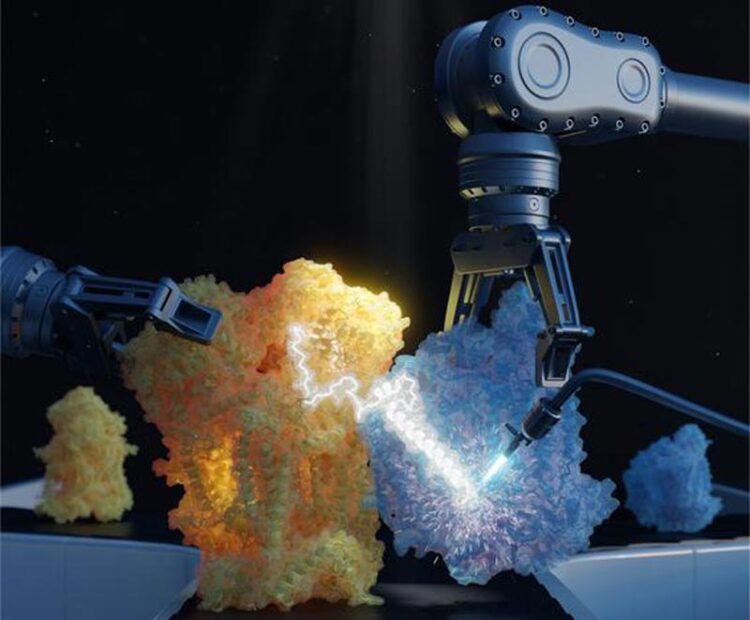Boosting the cell’s power house

Supercomplex CIII2CIV. When assembled into a supercomplex, the two parts of CIII2CIV are held together by a molecule that acts like a fishhook. This optimizes the cell metabolism.
© Verena Resch Luminous Lab/IST Austria
Scientists at IST Austria describe for the first time the structure of a protein complex essential for our cells to function properly. Study published in Nature.
Severe fatigue, muscle weakness, even blindness – mitochondrial diseases have various symptoms. In fact, the majority of genetic diseases are caused by defects of the mitochondria. Hence, understanding these “power houses” of our cells is crucial for the developments of new treatments. In a study published in the journal Nature, researchers at the Institute of Science and Technology (IST) Austria now show for the first time the structure of a protein complex essential for their work.
In order to fulfill their many tasks, cells need energy. In the cell’s power plants, known as mitochondria, the energy contained in our food is converted into the molecule ATP. It serves as a kind of fuel that drives most cellular processes – from muscle contraction to the assembly of our DNA. Professor Leonid Sazanov and Irene Vercellino are now the first scientists to precisely show what a protein assembly essential for this process looks like in mammalian cells.
Like a fishhook
Using cryo-electron microscopy, a technique that allows researchers to look at extremely small samples in their natural state, first author Irene Vercellino and Prof. Sazanov show the exact structure of the so-called supercomplex CIII2CIV. This assembly of protein building blocks pumps charged particles, protons, through the mitochondrial membrane, which is needed to start the energy conversion process in the cells. It therefore fulfills a similar task as the starter battery of cars. Up to now, this supercomplex has only been described in plant and yeast cells where it takes on a very different form, as the researchers now discovered. In order to understand how exactly energy production works in animal cells like our own, the scientists now took a close look at mice and sheep cells and were surprised.
“Nobody could have predicted the way SCAF1 acts,” says Sazanov. Previous studies already showed that the molecule SCAF1 plays a role in assembling the two protein complexes that together form supercomplex CIII2CIV. Instead of interacting with the two protein complexes on the surface only, the molecule goes deep inside complex III while being attached to complex IV. “It is like a hook swallowed by a fish. Once it’s swallowed it can’t get out,” the structural biologist explains.
Close, but not too close
Furthermore, the scientists show that supercomplex CIII2CIV takes on two different forms – a locked and an unlocked or mature one. “In its locked state some parts of complex III are still missing and the interaction between the two complexes is very intimate,” describes Sazanov. Once it is fully assembled, however, the two complexes are connected by SCAF1 without getting in each other’s way. “In order to fulfill its tasks, complex III probably prefers to be free from interference in its movements,” the Belarusian-British scientist assumes.
Being assembled into a supercomplex, on the other hand, speeds up their chemical reactions, which has great advantages for the animal. It has been shown, that mice and zebrafish missing the SCAF1 molecule are significantly smaller, less fit, and less fertile. In their recent study, Vercellino and Sazanov describe the molecule’s role in forming supercomplex CIII2CIV, which optimizes the cellular metabolism. It has been the final piece of the puzzle: together with their previous studies, Sazanov and his team now determined the structures of all supercomplexes in mammalian mitochondria. The team is thus laying the foundation for new treatments for mitochondrial disease.
Funding information:
This project was supported by funding from the European Union’s Horizon 2020 research and innovation program under the Marie Skłodowska-Curie Grant Agreement No. 754411.
Animal welfare
In order to better understand fundamental processes, for example, in the fields of neuroscience, immunology, or genetics, the use of animals in research is indispensable. No other methods, such as in silico models, can serve as alternative. The animals are raised, kept, and treated according to the strict regulations of Austrian law. All animal procedures are approved by the Federal Ministry of Education, Science and Research.
Originalpublikation:
Publication:
Leonid Sazanov & Irene Vercellino. 2021. Structure and assembly of mammalian mitochondrial supercomplex CIII2CIV. Nature. DOI: 10.1038/s41586-021-03927-z
Media Contact
All latest news from the category: Life Sciences and Chemistry
Articles and reports from the Life Sciences and chemistry area deal with applied and basic research into modern biology, chemistry and human medicine.
Valuable information can be found on a range of life sciences fields including bacteriology, biochemistry, bionics, bioinformatics, biophysics, biotechnology, genetics, geobotany, human biology, marine biology, microbiology, molecular biology, cellular biology, zoology, bioinorganic chemistry, microchemistry and environmental chemistry.
Newest articles

Superradiant atoms could push the boundaries of how precisely time can be measured
Superradiant atoms can help us measure time more precisely than ever. In a new study, researchers from the University of Copenhagen present a new method for measuring the time interval,…

Ion thermoelectric conversion devices for near room temperature
The electrode sheet of the thermoelectric device consists of ionic hydrogel, which is sandwiched between the electrodes to form, and the Prussian blue on the electrode undergoes a redox reaction…

Zap Energy achieves 37-million-degree temperatures in a compact device
New publication reports record electron temperatures for a small-scale, sheared-flow-stabilized Z-pinch fusion device. In the nine decades since humans first produced fusion reactions, only a few fusion technologies have demonstrated…





















